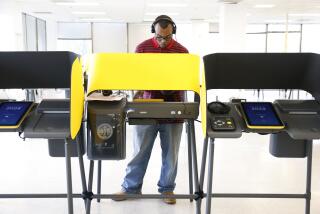The 36th District’s open primary
Among the political reforms that Californians have adopted in recent years in hopes of overcoming some of the obstacles to progress in Washington and Sacramento is the so-called open primary. Under this system, the traditional partisan primary — in which voters of each party selected their candidates in separate primaries and the winners then faced off against each other in a general election — has been abolished. From now on, all candidates, regardless of party, will compete in a first-round election. Voters will then choose between the two top vote-getters in a runoff.
That will be familiar to some California voters. It is, for instance, the system by which Los Angeles residents have long selected their leaders, including the mayor. It is new to state legislative and congressional races, however, and the race for the seat Rep. Jane Harman is vacating in California’s 36th Congressional District thus represents a test case of the new rules. Election day for the first round of voting is May 17.
Already, some of the open primary’s benefits, as well as some of its vulnerabilities, are on display. Although the district leans Democratic, six Republicans, a Libertarian, a Peace and Freedom candidate and three challengers with no identified party preference are among those seeking the seat.
One of the original selling points of the open primary was that theoretically it would discourage candidates from drifting toward the extremes of their parties in order to win the primary and then ride the partisan division in their district to victory in the general election. That’s partly at work here. For Janice Hahn and Debra Bowen, the leading Democratic contenders in this race, there’s no incentive to match Marcy Winograd’s more-liberal liberalism to win votes when they can just as easily find support in the Democratic center or even from moderate Republicans or independents who might back them in this round or the next.
At the same time, the particulars of this race — a short campaign, an expected low turnout, a big field — could mean that Bowen and Hahn, and perhaps Winograd, divide up the Democratic vote and open the door for a candidate with a relatively small base to make it into the runoff. If that’s the case, a moderate Republican such as Mike Gin could find his way to the next round, or even a candidate on the extremes who rode one issue to success in the first round (though that person might find it hard to prevail in the runoff).
Looking forward, this experiment will soon be layered on top of another. California’s citizen redistricting commission, another of the recent reforms put in place by voters, is working to redraw the state’s political lines. No matter who wins this race, the 36th District may soon change. Should its boundaries shift southward or westward, adding Rancho Palos Verdes, it could become more conservative, making it a more challenging seat for a Democrat to hold; should they move north and pick up Santa Monica, it could solidify the district as a Democratic bastion.
We have supported the open primary as well as the redistricting commission, but not because we believe that they will overturn California politics overnight. Not all open primaries will attract broad ranges of candidates; not all districts will be competitive. (No matter where one draws lines in West Los Angeles, for instance, they are bound to assemble mostly Democrats.) As a result, these are incremental reforms, but they have potential. If, over time, some of California’s legislative and congressional seats are more competitive, and if candidates who seek those offices see more upside in cutting deals than in obstructing them, some of the gridlock that dominates contemporary politics may ease.
The future of the 36th Congressional District — historic home to the aerospace industry, a bedroom community for union workers at the ports and airport, a place emblematic of the stresses of the modern economy — promises to test the political principles at work in these reform efforts. That gives next month’s election special resonance.
More to Read
A cure for the common opinion
Get thought-provoking perspectives with our weekly newsletter.
You may occasionally receive promotional content from the Los Angeles Times.





